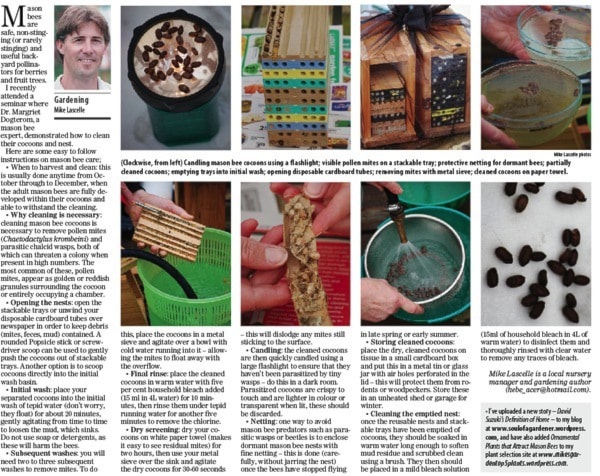Mason bees are safe, non-stinging (or rarely stinging) and useful backyard pollinators for berries and fruit trees.
I recently attended a seminar where Dr. Margriet Dogterom, a mason bee expert, demonstrated how to clean their cocoons and nest.
Here are some easy to follow instructions on mason bee care;
• When to harvest and clean: this is usually done anytime from October through to December, when the adult mason bees are fully developed within their cocoons and able to withstand the cleaning.
• Why cleaning is necessary: cleaning mason bee cocoons is necessary to remove pollen mites (Chaetodactylus krombeini) and parasitic chalcid wasps, both of which can threaten a colony when present in high numbers. The most common of these, pollen mites, appear as golden or reddish granules surrounding the cocoon or entirely occupying a chamber.
• Opening the nests: open the stackable trays or unwind your disposable cardboard tubes over newspaper in order to keep debris (mites, feces, mud) contained. A rounded Popsicle stick or screwdriver scoop can be used to gently push the cocoons out of stackable trays. Another option is to scoop cocoons directly into the initial wash basin.
• Initial wash: place your separated cocoons into the initial wash of tepid water (don’t worry, they float) for about 20 minutes, gently agitating from time to time to loosen the mud, which sinks. Do not use soap or detergents, as these will harm the bees.
• Subsequent washes: you will need two to three subsequent washes to remove mites. To do this, place the cocoons in a metal sieve and agitate over a bowl with cold water running into it – allowing the mites to float away with the overflow.
• Final rinse: place the cleaned cocoons in warm water with five per cent household bleach added (15 ml in 4L water) for 10 minutes, then rinse them under tepid running water for another five minutes to remove the chlorine.
• Dry screening: dry your cocoons on white paper towel (makes it easy to see residual mites) for two hours, then use your metal sieve over the sink and agitate the dry cocoons for 30-60 seconds – this will dislodge any mites still sticking to the surface.
• Candling: the cleaned cocoons are then quickly candled using a large flashlight to ensure that they haven’t been parasitized by tiny wasps – do this in a dark room. Parasitized cocoons are crispy to touch and are lighter in colour or transparent when lit, these should be discarded.
• Netting: one way to avoid mason bee predators such as parasitic wasps or beetles is to enclose dormant mason bee nests with fine netting – this is done (carefully, without jarring the nest) once the bees have stopped flying in late spring or early summer.
• Storing cleaned cocoons: place the dry, cleaned cocoons on tissue in a small cardboard box and put this in a metal tin or glass jar with air holes perforated in the lid – this will protect them from rodents or woodpeckers. Store these in an unheated shed or garage for winter.
• Cleaning the emptied nest: once the reusable nests and stackable trays have been emptied of cocoons, they should be soaked in warm water long enough to soften mud residue and scrubbed clean using a brush. They then should be placed in a mild bleach solution (15ml of household bleach in 4L of warm water) to disinfect them and thoroughly rinsed with clear water to remove any traces of bleach.
Mike Lascelle is a local nursery manager and gardening author. Email him at hebe_acer@hotmail.com.
Blog
• You can read a new story - David Suzuki’s Definition of Home – on Mike's blog at www.soulofagardener.wordpress.com, and see a list of ornamental plants that attract mason bees on his plant selection site at www.mikesgardentop5plants.wordpress.com.
